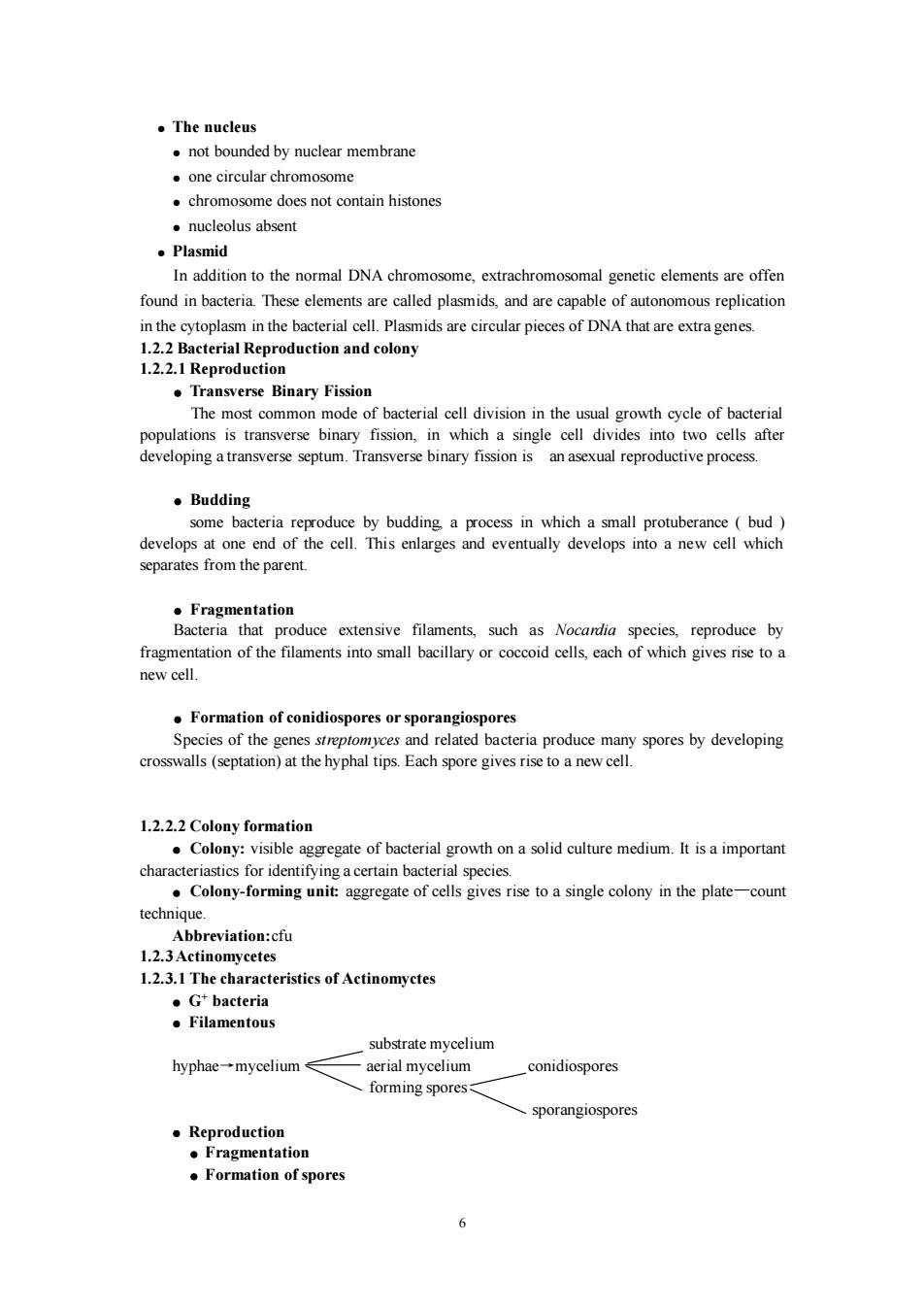正在加载图片...

6 ● The nucleus ● not bounded by nuclear membrane ● one circular chromosome ● chromosome does not contain histones ● nucleolus absent ● Plasmid In addition to the normal DNA chromosome, extrachromosomal genetic elements are offen found in bacteria. These elements are called plasmids, and are capable of autonomous replication in the cytoplasm in the bacterial cell. Plasmids are circular pieces of DNA that are extra genes. 1.2.2 Bacterial Reproduction and colony 1.2.2.1 Reproduction ● Transverse Binary Fission The most common mode of bacterial cell division in the usual growth cycle of bacterial populations is transverse binary fission, in which a single cell divides into two cells after developing a transverse septum. Transverse binary fission is an asexual reproductive process. ● Budding some bacteria reproduce by budding, a process in which a small protuberance ( bud ) develops at one end of the cell. This enlarges and eventually develops into a new cell which separates from the parent. ● Fragmentation Bacteria that produce extensive filaments, such as Nocardia species, reproduce by fragmentation of the filaments into small bacillary or coccoid cells, each of which gives rise to a new cell. ● Formation of conidiospores or sporangiospores Species of the genes streptomyces and related bacteria produce many spores by developing crosswalls (septation) at the hyphal tips. Each spore gives rise to a new cell. 1.2.2.2 Colony formation ● Colony: visible aggregate of bacterial growth on a solid culture medium. It is a important characteriastics for identifying a certain bacterial species. ● Colony-forming unit: aggregate of cells gives rise to a single colony in the plate—count technique. Abbreviation:cfu 1.2.3 Actinomycetes 1.2.3.1 The characteristics of Actinomyctes ● G+ bacteria ● Filamentous substrate mycelium hyphae→mycelium aerial mycelium conidiospores forming spores sporangiospores ● Reproduction ● Fragmentation ● Formation of spores6 ● The nucleus ● not bounded by nuclear membrane ● one circular chromosome ● chromosome does not contain histones ● nucleolus absent ● Plasmid In addition to the normal DNA chromosome, extrachromosomal genetic elements are offen found in bacteria. These elements are called plasmids, and are capable of autonomous replication in the cytoplasm in the bacterial cell. Plasmids are circular pieces of DNA that are extra genes. 1.2.2 Bacterial Reproduction and colony 1.2.2.1 Reproduction ● Transverse Binary Fission The most common mode of bacterial cell division in the usual growth cycle of bacterial populations is transverse binary fission, in which a single cell divides into two cells after developing a transverse septum. Transverse binary fission is an asexual reproductive process. ● Budding some bacteria reproduce by budding, a process in which a small protuberance ( bud ) develops at one end of the cell. This enlarges and eventually develops into a new cell which separates from the parent. ● Fragmentation Bacteria that produce extensive filaments, such as Nocardia species, reproduce by fragmentation of the filaments into small bacillary or coccoid cells, each of which gives rise to a new cell. ● Formation of conidiospores or sporangiospores Species of the genes streptomyces and related bacteria produce many spores by developing crosswalls (septation) at the hyphal tips. Each spore gives rise to a new cell. 1.2.2.2 Colony formation ● Colony: visible aggregate of bacterial growth on a solid culture medium. It is a important characteriastics for identifying a certain bacterial species. ● Colony-forming unit: aggregate of cells gives rise to a single colony in the plate—count technique. Abbreviation:cfu 1.2.3 Actinomycetes 1.2.3.1 The characteristics of Actinomyctes ● G+ bacteria ● Filamentous substrate mycelium hyphae→mycelium aerial mycelium conidiospores forming spores sporangiospores ● Reproduction ● Fragmentation ● Formation of spores